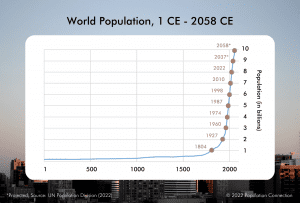We recently posted a blog, “What is Carrying Capacity?” and concluded with the question, “what is our human carrying capacity?” This is a question that demographers, scientists and economists have been trying to answer for years, yet the answer still remains, “it depends.” Let’s explore…
We can think of carrying capacity as being determined by three main factors, 1. The size of the population, 2. The amount of resources in an area and, 3. How the population uses the available resources.
According to some calculations, it takes 2.1 hectares of land and water to provide food, clothing, shelter, fresh air and other necessities for the average human. For the average American however, meeting these same needs requires a whopping 8 hectares of land. Compare that to the average Bangladeshi, who requires only 0.6 hectares. And consider this: the current global ecological footprint, the time it would take to regenerate the resources we use in one year, is 1 ½ years. Yet if everyone on the planet consumed resources as Americans do, we’d need the resources of four earths to sustain us. (For similar comparisons, check out our Degree of Impact cards). Clearly, our human carrying capacity depends not just on how many of us there are, but also on how we’re using our resources.
Now read a post exploring how (and why!) address this complex question in your K-12 classroom.



